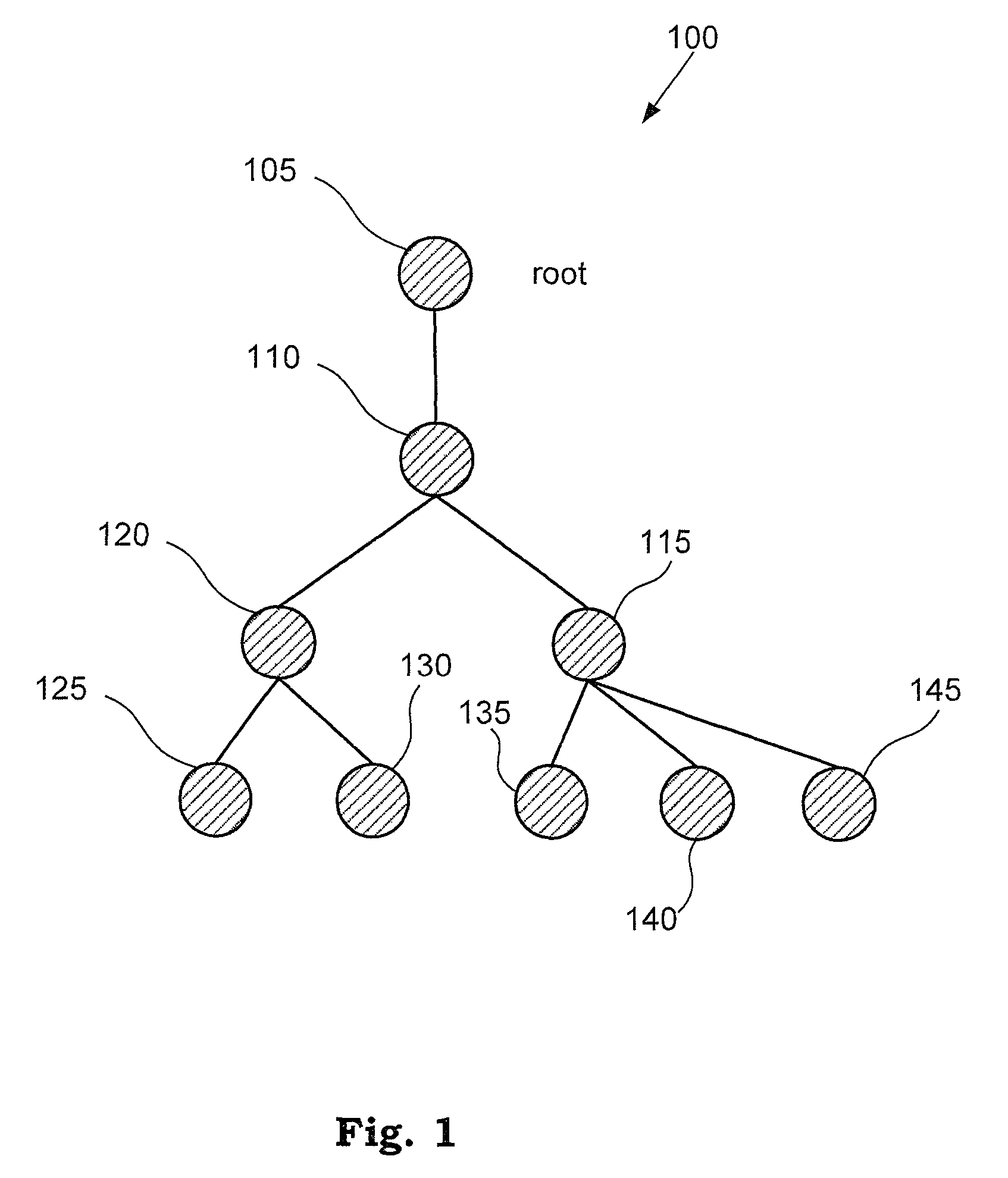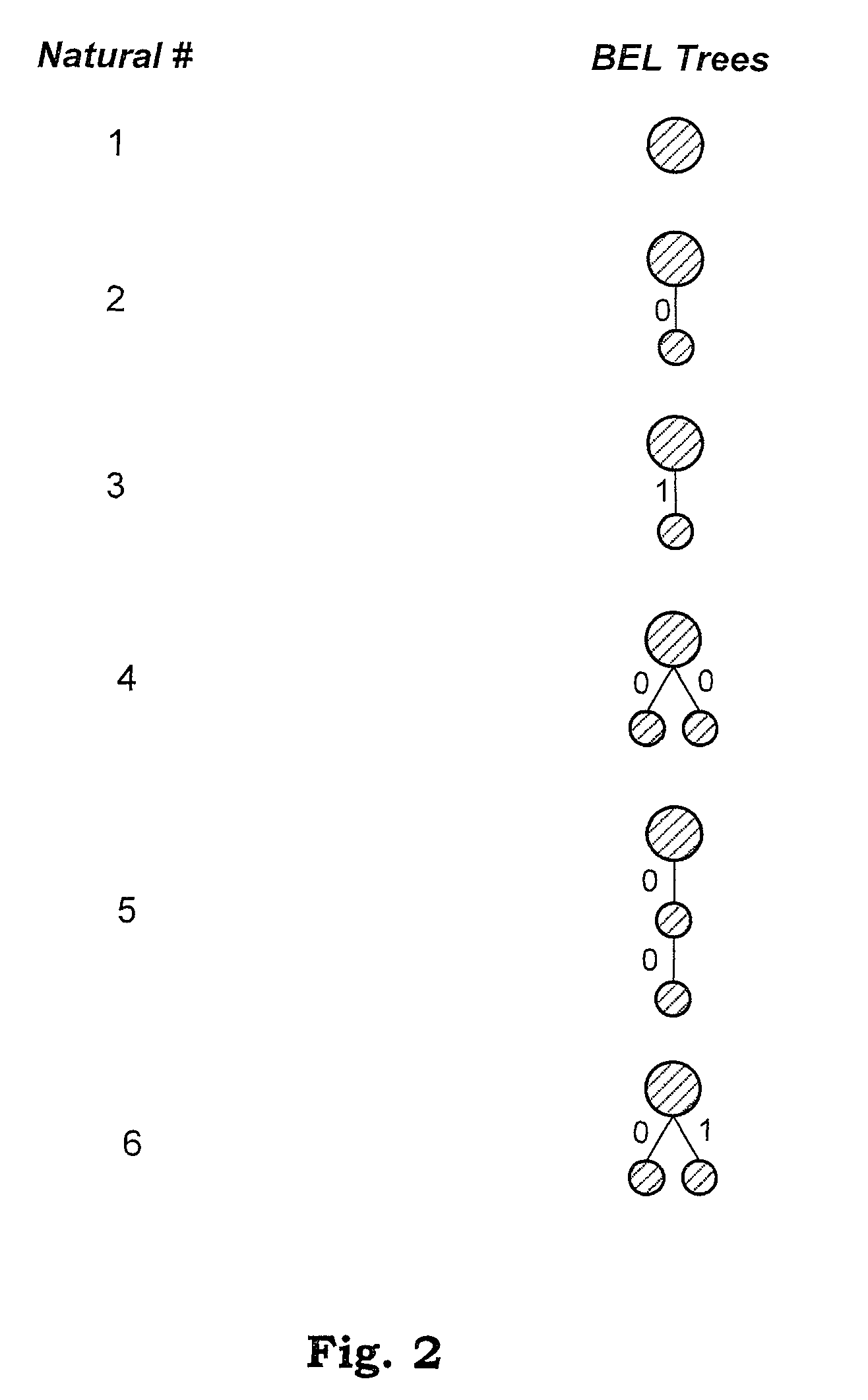Method and/or system for transforming between trees and strings
a tree and string technology, applied in hierarchical databases, instruments, program control, etc., can solve the problems of cumbersome operations, computational complexity, and inability to straight-forward manipulate such data representations,
- Summary
- Abstract
- Description
- Claims
- Application Information
AI Technical Summary
Benefits of technology
Problems solved by technology
Method used
Image
Examples
embodiment 100
[0019]As previously discussed, in a variety of fields, it is convenient and / or desirable to represent data, a set of data and / or other information in a hierarchical fashion. In this context, such a hierarchy of data shall be referred to as a “tree.” In a particular embodiment, a tree may comprise a finite, non-empty (including at least one node), rooted, connected, acyclic graph. Likewise, such trees may be either ordered or unordered. Further discussion of non-empty trees may be found in The Art of Computer Programming, Vol. 1, Fundamental Algorithms, Donald Knuth, Addison Wesley. Here, ordered refers to the notion that there is an ordering or precedence among nodes attached to a common node corresponding to the order of the attached nodes shown in a graphical illustration. An unordered tree is illustrated here, for example, in FIG. 1 by embodiment 100. As illustrated, the root of this particular embodiment encompasses node 105. In addition to 105, there are eight other nodes desig...
embodiment 510
[0039]To assist in understanding the relationship between the symbolic expression shown in FIG. 4 and tree 400, for this particular embodiment, FIG. 5 provides an embodiment 510 of another tree. As illustrated, tree 510 comprises an edge label D connecting two nodes. For this particular context, this embodiment may be expressed symbolically as follows: D(1). Thus, a technique to describe the embodiment of tree 510 would refer to the “push” of the natural numeral 1. Here, for this particular embodiment, this particular push operation comprises the “D” push of 1, resulting in D being the label of the edge connecting the two nodes. More specifically, as previously described, a single node is associated with the natural numeral 1 in this particular embodiment. To perform a push operation, an edge is attached to that node and labeled. Here, applying a D push, the label provided comprises the label D.
[0040]Continuing, the “C” push of “1” is illustrated as two nodes with an edge labeled C ...
embodiment 900
[0052]As pointed out above, according to a particular embodiment, in general a concatenation of symbol strings for a concatenation operation results in a symbol string associated with a numeral that is a product of numerals representing respective concatenated symbol strings. However, an exception is that in the particular embodiments illustrated in FIGS. 7 through 11, multiplication of a numeral associated with a symbol string by a factor of two may be represented by the concatenation of a single pair of open and close symbols (e.g., “( )” for embodiments 700, 1000 and 1100, “{ }” for embodiment 800 and “[ ]” for embodiment 900) which in this embodiment represents a tree associated with numeral one. Thus, in these particular association embodiments, multiplication by a power of two, 2n, may be expressed as a concatenation of a symbol string comprising a sequence of n such grouping symbol pairs. However, this is merely an example of how a multiplication of numerals by a power of two...
PUM
 Login to View More
Login to View More Abstract
Description
Claims
Application Information
 Login to View More
Login to View More - R&D
- Intellectual Property
- Life Sciences
- Materials
- Tech Scout
- Unparalleled Data Quality
- Higher Quality Content
- 60% Fewer Hallucinations
Browse by: Latest US Patents, China's latest patents, Technical Efficacy Thesaurus, Application Domain, Technology Topic, Popular Technical Reports.
© 2025 PatSnap. All rights reserved.Legal|Privacy policy|Modern Slavery Act Transparency Statement|Sitemap|About US| Contact US: help@patsnap.com



